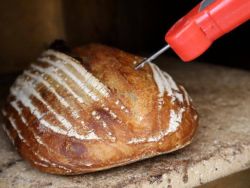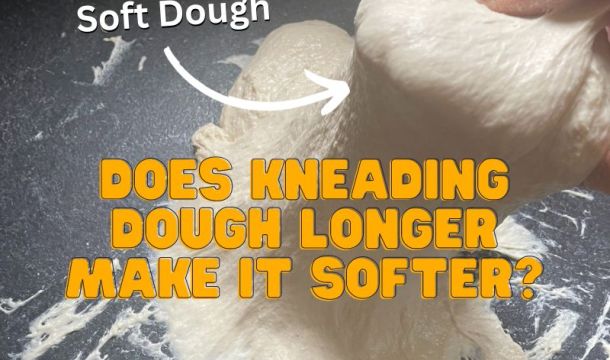
How To Tell When Bread Is Done With Or Without A Thermometer

Taking freshly baked bread out of the oven is one of the best parts of baking. But, how do you know if your bread is done baking? Well, many bakers use an instant-read thermometer to check the core temperature of the bread, but you can learn to tell if bread is baked without one. If you also want to know how to tell when your bread is done with or without a thermometer, continue reading!
A perfectly baked bread should have a deep golden-brown crust, a firm texture, and a largely dry interior. An instant-read thermometer is the most accurate way to check the doneness of bread. As you enhance your baking skills, you will learn to be equally confident that your bread is done by looking at it.
How to take a temperature reading of bread
For this, you’ll need a thermometer that has a probe. A laser thermometer isn’t ideal, as you’ll want to take a reading from the centre of the bread.
To take a temperature reading, either do this inside the oven or remove the loaf with oven gloves and do it outside. If your probe is an “instant-read” model, it’s better to do it in the oven.
Push your probe into the bread, positioning the probe tip roughly in the loaf’s centre. Turn on your probe and wait for the temperature dial to settle. The bread can be removed and left to cool if the reading reaches your target temperature.

What is the best bread thermometer?
A thermometer like the GDealer DT09 is perfect for testing the core temperature of the bread. It’s the one I use at home. I like it because it reads the temperature in under 4 seconds, hasn’t fallen apart after the numerous times I’ve dropped it, and the batteries are cheap and easy to change.
I use it mainly for bread, but also to check that I haven’t undercooked chicken and when making the perfect medium-rare beef for Mrs Busby-to-be.

Get your dough thermometer on Amazon
The ideal internal temperature of bread in Celsius
There are many types of bread, and the perfect doneness temperature differs between them. For hard and crusty bread, the internal temperature should be between 90-99C or 200-210F. Meanwhile, for soft types of bread like dinner rolls, it should reach 87-93C or 190-200F.
Note: To be precise, the temperature of the bread should pass 90C for 10% of the bake. This means for a 35-minute bake, the bread should pass 90C after 31.5 minutes. This is too hard to measure in a home bakery (and many professional ones!), but it’s a handy point to know.
What does undercooked bread look like?
Bread is distinguished as undercooked by its texture and firmness. A typical sign of undercooked bread is when it’s too soft, close to the texture of the original raw dough. The inside part will be doughy, soggy, and may even have wet spots. Although the crust can colour early when the baking temperature is too high, it’s often noticed that the crust is not a deep golden brown colour.
Underbaking is a common reason why bread collapses after baking. Most bread that’s way undercooked lacks the nice aroma of freshly baked bread. Instead, it will smell raw and doughy.
How to tell if bread is done without a thermometer
If you don’t have access to a thermometer, there are two simple steps that you can use to check your bread’s doneness:
Tapping the bottom
The first method you can use is to tap the bottom part of the bread.
Simply take the loaf from the oven or baking pan and turn it upside down. Give the bottom part a firm tap with your thumb or finger. It should make a heavy or hollow sound.
A hollow sound means that the inside part of your bread is cooked and ready to cool down. If it sounds dull, put it back in the oven.
Using a toothpick
Using a toothpick isn’t just applied to cake making. It can be used when baking bread as well! You just need to stick the toothpick into the bread.
The bread is finished baking if the toothpick comes out clean with just a few moist crumbs. But if it comes out with many damp crumbs or you see uncooked batter, it needs more time in the oven.
How long should you bake bread
Of course, different types of bread have different periods to be cooked in the oven. Some of them are listed in the table below:
| Type of Bread | Oven Time |
|---|---|
| Quick bread | 32-36 minutes |
| Buns and rolls | 10-16 minutes |
| Thick flatbreads | 20-28 minutes |
| Thin flatbreads | 3-15 minutes |
| Sourdough bread | 33-42 minutes |
Can you overcook bread?
Yes, bread can always be overcooked. Most bakers don’t advise overcooking your bread unless it’s your preference. Overbaking makes the bread dry and tough, the complete opposite of what bread should be!
How long to cool bread after baking?
I know it’s tempting to tuck into your bread as soon as it has left the oven, but for the best flavour and texture, bread should cool down before slicing. Use your temperature probe to check that the temperature of the bread has dropped below 35C (95F). It should take 2-3 hours for most types of bread to cool.
Frequently asked questions when telling when bread is done
If you’ve enjoyed this article and wish to treat me to a coffee, you can by following the link below – Thanks x

Hi, I’m Gareth Busby, a baking coach, senior baker and bread-baking fanatic! My aim is to use science, techniques and 15 years of baking experience to make you a better baker.
Table of Contents
- How to take a temperature reading of bread
- What is the best bread thermometer?
- The ideal internal temperature of bread in Celsius
- What does undercooked bread look like?
- How to tell if bread is done without a thermometer
- How long should you bake bread
- Can you overcook bread?
- How long to cool bread after baking?
- Frequently asked questions when telling when bread is done
Related Recipes
Related Articles
Latest Articles
Baking Categories
Disclaimer
Address
53 Greystone Avenue
Worthing
West Sussex
BN13 1LR
UK







